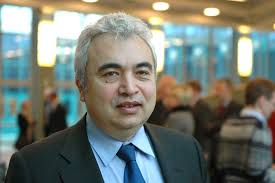Turkey could be the exporter of renewable energy technologies and its know-how to potential Middle Eastern. Caucasian and African markets if the country can successfully realize its Renewable Energy Resource Zones projects and increase its potential. Executive Director of International Energy Agency (IEA) told Anadolu Agency.
Turkey. with its limited domestic resources and dependency on expensive energy imports. strives to increase the share of renewables in its energy mix. The country launched an initiative. Renewable Energy Resource Zones. to increase investments in and electricity generation from the renewables. Last year. the country had tenders for 1.000 solar and 1.000 megawatts as a part of this initiative. of which the prices per megawatt hour were $6.99 and $3.48. respectively.
IEA Executive Director. Dr. Fatih Birol. said in a recent interview that the model of Renewable Energy Resource Zones is perfect for utilizing Turkey`s renewable potential. especially in solar and wind.
`The renewables are not only good for Turkey in terms of climate change targets but also in terms of energy security. Because the more Turkey has renewables in the mix. the less it will be dependent on imports which largely contribute to the country`s current account deficit.` he said.
Also. the costs of renewables are falling and this could enable more investments. he said.
`That was actually one of my dreams that Turkey. while importing gas and oil from the Middle East. could export renewable energy technologies. know-how and investment to its region. Even though the Middle East has the highest solar potential in the world. the countries here do not have enough experience to utilize this potential.` Birol explained.
`Thus. I think Turkey could play a significant role in terms of exports to the Middle East. Caucasian. Africa. too. could also be a very good export market for Turkey.` he said.
Climate change targets at risk
Birol said these steps in bolstering Turkey`s renewables expansion is also helping the efforts to tackle climate change. which energy sector is the largest contributor to the emissions.
At COP 21 in Paris. on Dec. 12. 2015. parties reached a landmark agreement to combat climate change and to accelerate and intensify the actions and investments needed for a sustainable low carbon future. The Paris Agreement aims to keep a global temperature rise this century below 2 degrees Celsius above pre-industrial levels and to maintain efforts to limit the temperature increase even further to 1.5 degrees Celsius.
The parties to Paris Agreement agreed on a `book of rules` that provides a guideline for realizing the targets in the 24th Session of the UN Climate Change Conference (COP24) held on Dec. 2-14 in Katowice. Poland.
`All these steps. studies and targets are so special and precious but these targets do not reflect the data in the real life.` Birol said and added that the global emissions of carbon dioxide do not fall or remain stable but instead rise.
`At IEA. when we look at the data for the first 11 months of 2018. we see that global emission of carbon dioxide is going to hit a historic high. Thus. I do not want to say yet that it is impossible to achieve the targets of Paris Agreement but it is getting harder.` Birol concluded.
 Iran Energy News Oil, Gas, Petrochemical and Energy Field Specialized Channel
Iran Energy News Oil, Gas, Petrochemical and Energy Field Specialized Channel




